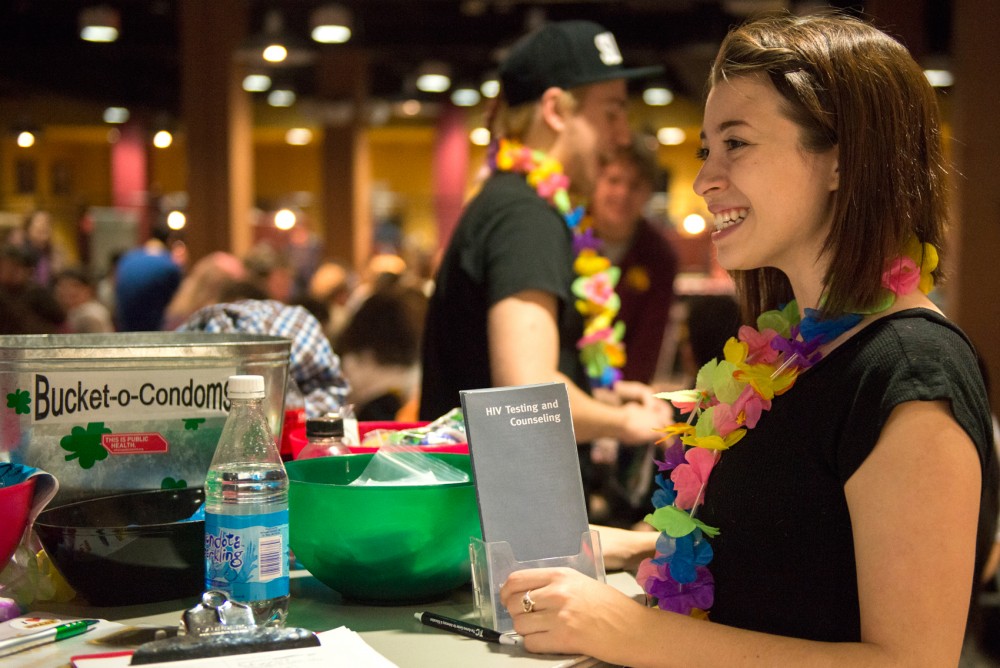Many University of Minnesota students are coordinating Valentine’s Day arrangements with friends and lovers, but not all of them are making plans to use condoms.
During Boynton Health Service’s Safer Sex Week last week, student health groups passed out free condoms to anyone who would take them, but student condom use is lower than ever, according to the 2015 Student Health Survey.
According to the survey, as the use of condoms is lagging from past years, diagnosed sexually transmitted diseases and infections — like chlamydia and genital warts — have increased on campus.
The trend is nationwide, as STDs affect people from ages 15 to 24 more than other age groups, according to a 2014 study by the Centers for Disease Control and Prevention. That age range accounts for two-thirds of the reported chlamydia and gonorrhea cases.
The student survey didn’t break down STD diagnoses by gender or sexuality, but the CDC reported there is an “increasing burden” among women and gay or bisexual men.
University Student Health Advocate and Biochemistry sophomore Mateo Frumholtz hands out free condoms and lubricant to students from his dorm room in Centennial Hall, but getting students to ask for them can be hard.
“Some people feel embarrassed,” Frumholtz said. “Instead of seeking those resources, they just risk it.”
Last year, about 52 percent of students said they used a condom the last time they had vaginal intercourse. Dave Golden, Boynton’s director of public health and communications, said this year is the first time that number fell below 60 percent.
Golden said the drop in condom use could show that students are letting their guard down and feeling a false sense of protection from the use of other, more popular contraceptives.
According to the study, oral birth control pills were the top pregnancy-prevention method in 2015 over condoms — which were the front-runners since before 2010.
“The big thing is pregnancy, and the second thing is STI prevention,” Frumholtz said. “So they think if they take care of one, they don’t really have to worry about the others. And some of those beliefs might have led to the increase in STIs.”
Dating Apps and Disease
Mobile phone apps like Tinder have also gained popularity on college campuses, which some have blamed for the rise in STDs.
Last fall, the AIDS Healthcare Foundation received a cease-and-desist request from Tinder after it posted a West Hollywood, Calif., billboard showing silhouettes of a man and woman with “Tinder” and “chlamydia” on their heads.
Last year, a Rhode Island Department of Health study said the rise of STDs is partly due to an increase of “high-risk behaviors.”
“High-risk behaviors include using social media to arrange casual and often anonymous sexual encounters, having sex without a condom, having multiple sex partners and having sex while under the influence of drugs or alcohol,” the study said.
Tinder and Grindr have both added a health safety feature to their apps and websites, including a link to an STD-testing locator map for users who want to get tested.
The Minnesota AIDS Project makes profiles on these “hookup” sites and apps to spread AIDS prevention and testing information, said communications manager Andy Birkey
He said apps can increase the number of sexual partners people have, which adds to their risk of spreading diseases.
“There are lots of ways we can stem the rise in STDs,” Birkey said. “One of the things that MAP does every year at the capitol is advocate for comprehensive sex ed in public schools.”
Still, Golden said many still wrongly think that college students are more promiscuous. But they have fewer sex partners in a year than people in the same age group who are not in school, he said, pointing to the 79 percent of students who reported having zero or one partner in the last 12 months.
“[Students] tend to seek out monogamous relationships, and that is of lower risk for sexually transmitted infections,” Golden said.


